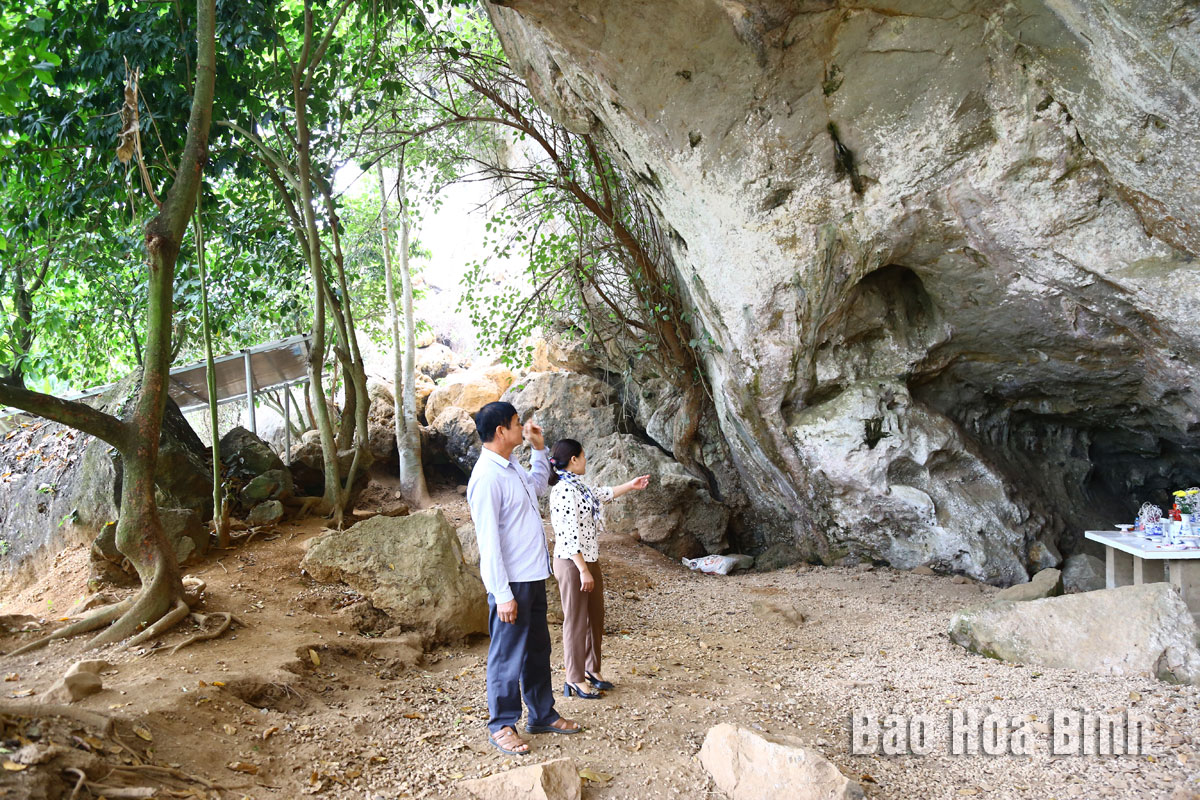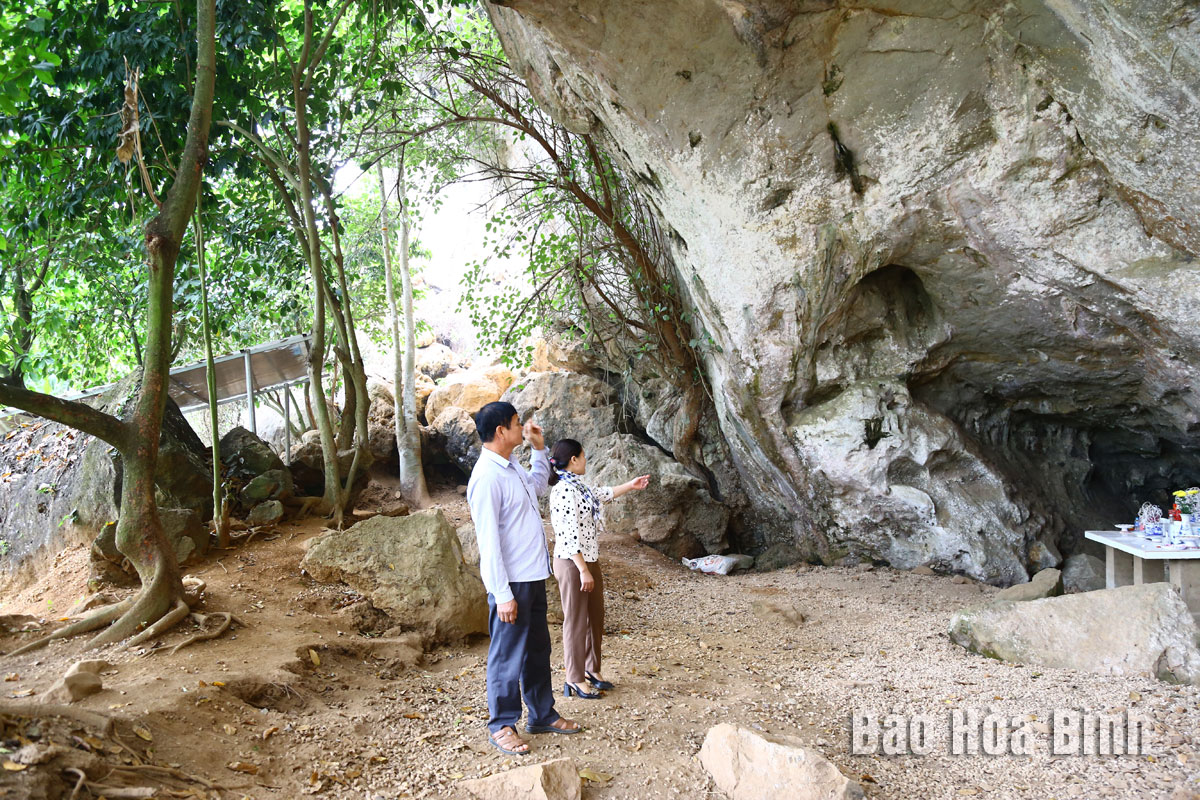
Holding unique values representing the world-famous Hoa Binh Civilisation, the archaeological sites of Trai Hamlet Cave and Vanh Village Stone Shelter in Lac Son district were recognised as special national relic sites in July.
Local residents have paid attention to protecting
natural landscape and environment around special national relic site of Vanh
Village Stone Shelter in Yen Phu commune, Lac Son district.
Exploring
Trai Hamlet Cave, Vanh Village Stone Shelter
Trai Hamlet Cave is located on a separate
limestone mountain, 15m above a nearby valley. It is more than 13m deep and has
an entrance 8m wide and 10m high. It contains food traces of early humans,
mainly stream and mountain snails. Statistics show that there are more than
30,000 shells per cubic metre of sediment inside this cave. Archaeologists have
found a substantial number of animal bone pieces here. Analyses indicate that
these are bones of animals living in the surrounding environment that early
humans caught for food. Rice husks and some half-burned grains have also been
discovered at a depth of 0 - 80cm underground, and they could belong to later
periods. This cave was listed as a national historical relic site in 2001.
Not far from Trai Hamlet Cave, Vanh Village
Stone Shelter is located at the foot of Da Trang (White Stone) Mountain in Vanh
village of Yen Phu commune. It is a relatively large stone shelter which is 18m
deep and has a 30m-wide entrance. It is about 5m higher than the surrounding
valley. The site was discovered and excavated by M. Colani in 1929 and also
named by the French archaeologist. Excavations at this place have revealed a
3.7m-thick cultural layer that contains mainly snails, clay, ashes, and mollusc
shells. Stone objects, human and animal bone pieces, horns, ceramic items,
stoves, and snail shells have also been found here. The shelter was named a
national historical relic site in 2003.
Promoting
relic sites’ values
Given their precious values, the two national
archaeological relic sites were recognised as special ones on July 18, 2024.
Bui Van Hung, head of the culture and
information division of Lac Son district, said that home to the two
archaeological relic sites typical for the prehistoric Hoa Binh Civilisation,
Lac Son has continually paid attention to the management, protection,
preservation, and promotion of the sites’ values. It is stepping up
communications about the places’ significance and values among the entire local
population so as to attract the public’s support for protecting the surrounding
landscape and environment. Tourism, learning, and scientific research
activities connected with the sites are also being promoted.
In the time ahead, to bring into full play the
values of these two special national relic sites, local authorities will
continue to seriously carry out management and protection activities in line
with the Law on Cultural Heritage, devise appropriate policies to encourage and
create conditions for people and businesses to engage in relic protection and
tourism development, and build new roads to connect arteries with the two
sites.
Additionally, the district will propose relic
management and rehabilitation measures to higher-level authorities in an effort
to become a destination on the tourism maps of Hoa Binh province, the region, and
the country, he added.
Hoa Binh province has carried out multiple programmes and initiatives to revive its cultural heritage which has gradually fallen into oblivion through the ebbs and flows of history.
The most prominent and defining feature in the prehistoric era of Hoa Binh is the Hoa Binh Culture. The Culture was first discovered in Hoa Binh. The significant prehistoric culture represents not only Vietnam but also Southeast Asia and southern China. Through excavations of cave sites in the limestone regions of Hoa Binh, French archaeologist M. Colani introduced the world to a "Stone Age in Hoa Binh province – Northern Vietnam" in 1927. On January 30, 1932, the First Congress of Far Eastern Prehistorians, held in Hanoi, officially recognised the Hoa Binh Culture.
Known as the "Land of Epic History”, Hoa Binh province, the gateway to Vietnam’s northwest, boasts a strategic location and a unique cultural tapestry woven by its ethnic minority communities.
The People's Committee of Luong Son District recently held a ceremony to receive the certificate recognizing Sau Communal House in Thanh Cao Commune as a provincial-level historical and cultural site.
Recognising the importance of cultural heritage preservation in protecting and promoting the value system of Vietnamese culture, and serving socio-economic development in the new period, Party committees and local administrations in Hoa Binh province have identified it as a key task in the cultural development strategy. The province has been making efforts in mobilising resources, creating consensus among people and engaging ethnic communities in preserving and promoting cultural identity.
Hoa Binh province has captured growing attention both domestically and internationally for its distinctive cultural heritage and rich history. Most notably, it has been renowned for its famous Hoa Binh culture, considered the cradle of ancient Vietnamese civilisation. Looking ahead to significant milestones in 2025 and the 140th anniversary of province establishment in 2026, Hoa Binh Newspaper presents a comprehensive overview of the province's development across economic, social, cultural, tourism, and security domains.



